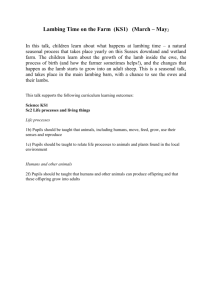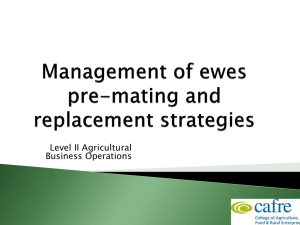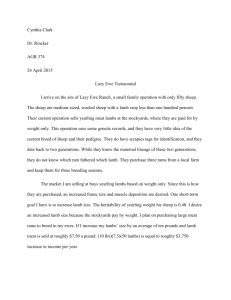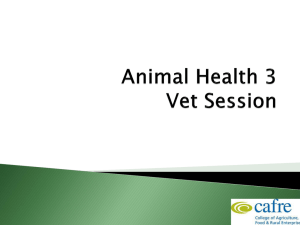Selection to Increase Fertility in Fall Lambing
advertisement
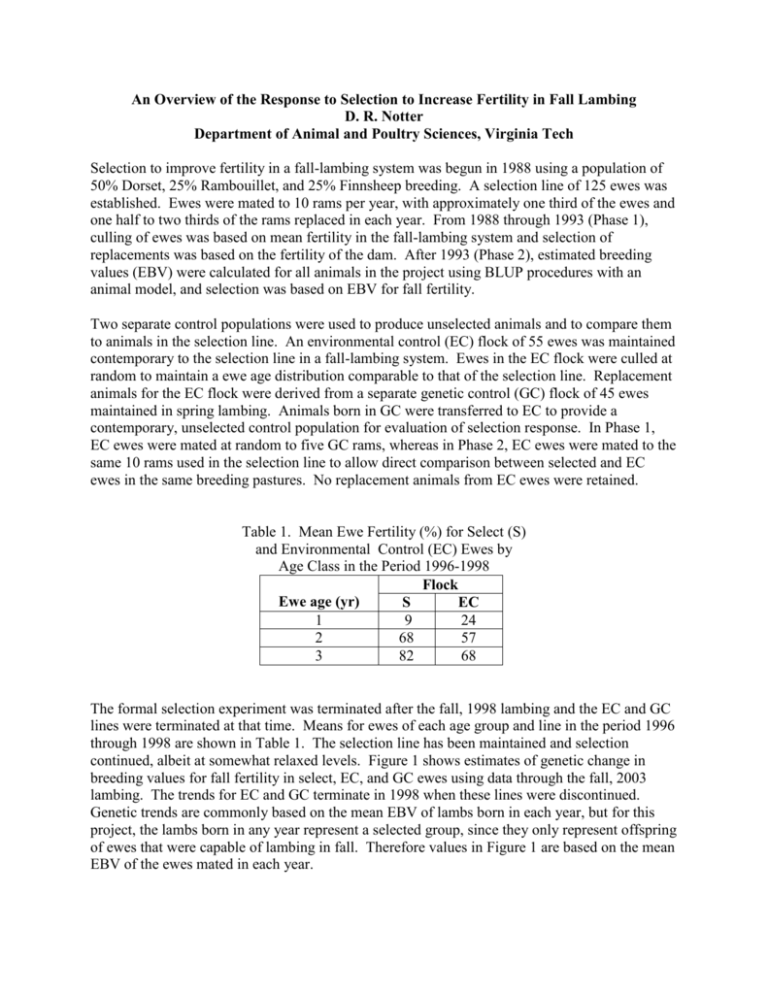
An Overview of the Response to Selection to Increase Fertility in Fall Lambing D. R. Notter Department of Animal and Poultry Sciences, Virginia Tech Selection to improve fertility in a fall-lambing system was begun in 1988 using a population of 50% Dorset, 25% Rambouillet, and 25% Finnsheep breeding. A selection line of 125 ewes was established. Ewes were mated to 10 rams per year, with approximately one third of the ewes and one half to two thirds of the rams replaced in each year. From 1988 through 1993 (Phase 1), culling of ewes was based on mean fertility in the fall-lambing system and selection of replacements was based on the fertility of the dam. After 1993 (Phase 2), estimated breeding values (EBV) were calculated for all animals in the project using BLUP procedures with an animal model, and selection was based on EBV for fall fertility. Two separate control populations were used to produce unselected animals and to compare them to animals in the selection line. An environmental control (EC) flock of 55 ewes was maintained contemporary to the selection line in a fall-lambing system. Ewes in the EC flock were culled at random to maintain a ewe age distribution comparable to that of the selection line. Replacement animals for the EC flock were derived from a separate genetic control (GC) flock of 45 ewes maintained in spring lambing. Animals born in GC were transferred to EC to provide a contemporary, unselected control population for evaluation of selection response. In Phase 1, EC ewes were mated at random to five GC rams, whereas in Phase 2, EC ewes were mated to the same 10 rams used in the selection line to allow direct comparison between selected and EC ewes in the same breeding pastures. No replacement animals from EC ewes were retained. Table 1. Mean Ewe Fertility (%) for Select (S) and Environmental Control (EC) Ewes by Age Class in the Period 1996-1998 Flock Ewe age (yr) S EC 1 9 24 2 68 57 3 82 68 The formal selection experiment was terminated after the fall, 1998 lambing and the EC and GC lines were terminated at that time. Means for ewes of each age group and line in the period 1996 through 1998 are shown in Table 1. The selection line has been maintained and selection continued, albeit at somewhat relaxed levels. Figure 1 shows estimates of genetic change in breeding values for fall fertility in select, EC, and GC ewes using data through the fall, 2003 lambing. The trends for EC and GC terminate in 1998 when these lines were discontinued. Genetic trends are commonly based on the mean EBV of lambs born in each year, but for this project, the lambs born in any year represent a selected group, since they only represent offspring of ewes that were capable of lambing in fall. Therefore values in Figure 1 are based on the mean EBV of the ewes mated in each year. Through 1998, the average increase in EBV in the selection line was 1.42 ± 0.05 %/yr. After termination of the formal selection project in 1998, mean EBV declined in 2001 and 2002, in part because of the use of high EBV ewes in semi-intensive projects. However, after the return of many of these ewes to the flock in 2003, mean EBV returned to its previous level. A substantial environmental trend in fertility was also observed, as shown by the pattern of change in year effects (adjusted for mean EBV) in Figure 2, although the variation among years was substantial. In the first year of the study, fertility was very low, likely in response to moving the animals from spring lambing to fall lambing. After excluding the observation for 1988, the average change in fertility due to nongenetic factors was 1.32 ± 0.91 %/yr (P = 0.18). We suspect that there is an element of adaptation involved in out-of-season breeding, as well as possible social effects whereby the presence of a critical proportion of cycling ewes in the flock may stimulate remaining anestrous ewes to cycle. Ten years of combined genetic and environmental trends, with cumulative positive effects of approximately 14 and 13%, respectively, can explain the increase in mean fertility of adult ewes from about 60% for this composite line in 1989 to the current mean fertility of around 87%. Part of the rationale for termination of the line was that further increases will be difficult given the categorical expression of this trait. While the theoretical ceiling would be 100% fertility, the reality of the situation is that the current fertility is approaching that which could reasonably be expected for single-sire matings in the normal fall breeding season. Figure 1. Changes in mean fall fertility EBV over time for ewes mated in the selected (S), environmental control (E), and genetic control (G) lines. S E G Fall fertility EBV, % 16 12 8 4 0 -4 -8 1988 1990 1992 1994 1996 Year 1998 2000 2002 2004 Figure 2. Changes in environmental effects (year constants) for fall fertility. Year constant, % Year effect 5 0 -5 -10 -15 -20 -25 -30 -35 -40 1988 1990 1992 1994 1996 1998 2000 2002 2004 Year Effect of Lamb Separation on Rebreeding of Lactating Ewes D. R. Notter and H. B. Vanimisetti Department of Animal and Poultry Sciences, Virginia Tech Over 2 yr (2003 and 2004), 71 ewes (61from the Virginia Tech out-of-season lambing flock and 10 purebred Dorsets) were evaluated for ability to cycle in March while lactating. Treatment schedules are shown in Table 2. Ewes lambed between December 30 and January 23; mean lambing dates were January 6 in 2003 and January 11 in 2004. At the start of the experiment in early March, two blood samples were collected 7 to 10 days apart from each ewe and assayed for progesterone to identify ewes that had an active CL. Ovulation was assumed to have occurred if circulating progesterone levels exceeded 1 ng/ml on one of the 2 d. Dorset ewes were represented only in 2004. Ewes were stratified by lambing date, age, and breed and assigned to a control group or a group that would be separated from their lambs for 72 h at the time of ram introduction. In mid-March, all ewes began a 5-d regimen of twice-daily subcutaneous injections of 25 mg of progesterone dissolved in corn oil. Ewes induced to ovulate by ram introduction often ovulate but do not express estrus, and can be induced to exhibit estrus by progesterone pretreatment. The last progesterone injection was given intramuscularly for faster clearance and, therefore, a more abrupt progesterone withdrawal. Ewes in the lamb-separation group were removed from their lambs the next morning, and two fertile rams were placed with each treatment group on that afternoon. Ewes and lambs from the two treatment groups, and all four breeding rams, were Table 2. Treatment schedules for lamb separation experiment in 2003 and 2004 Activity Year 2003 2004 Mean lambing date January 6 January 11 First pretreatment measure of circulating progesterone February 27 March 3 Second pretreatment measure of circulating progesterone March 10 March 10 Begin progesterone injections March 12 March 10 Lambs removed and rams introduced March 17 March 15 First blood sample March 18 March 16 Lambs returned March 20 March 18 Rams removed April 22 April 21 Ultrasonic pregnancy diagnosis May 29 June 14 recombined 3 d after lamb separation. Jugular blood samples were collected thrice weekly (Tuesday, Thursday, and Saturday) from all ewes for 5 wk beginning the day after lamb separation. Rams were equipped with marking harnesses, and marks were recorded at each bleeding date. Rams were removed in late April. Ewes were thus an average of 64 d postpartum at the start of breeding and an average of 104 d postpartum at the end of breeding. No obvious undesirable effects of lamb separation were observed. Lambs were consuming creep feed ad libitum before separation from their mothers and remained in the same pens with control ewes and lambs during the period of separation. Excessive engorgement of the udders was not observed in ewes separated from their lambs for 3 d. Reproductive performance of ewes in the two treatment groups is shown in Table 3. Results were consistent across years. No differences in mating behavior were observed between ewes that were separated from their lambs and control ewes. Over 70% of the ewes had elevated progesterone levels suggestive of ovulation prior to the start of progesterone pretreatment at an average of 52 to 63 d postpartum. An average of 85% of the ewes in each treatment group mated within 2 wk of ram introduction, and an additional 6% mated over the next 3 wk. These results suggest that most ewes exposed to rams at this time either mate promptly or do not mate at all. Ultrasonic pregnancy diagnosis in early June resulted in detection of pregnancy in 85% of the ewes. Thus, many of the ewes in this study did not appear to be anestrus prior to April 1, even when lactating. Actual lambing rates in August, however, were somewhat less encouraging than results of June pregnancy tests. Although results were complicated somewhat by a dog attach that resulted in the death of seven ewes and are only available for 2003, the average lambing rate of approximately 65% was considerably lower than the ultrasonically determined June pregnancy rate of 77%. These results suggest that lamb losses in late pregnancy may have been substantial in these ewes. Dorset ewes in the Virginia Tech flock are normally mated in April for September lambing and generally have lower fertility rates than selected crossbred ewes mated in May. However, the Dorset ewes evaluated in 2004 gave no indication of poorer fertility while lactating compared to crossbred ewes. The good performance of these Dorset ewes raises several questions about whether the somewhat mediocre fall-lambing performance of Dorset ewes in our flock is related to lamb losses in late pregnancy, or could perhaps be improved by running Dorset ewes with either crossbred teaser rams or cycling crossbred ewes. Table 3. Reproductive performance of ewes exposed to rams while lactating and effects of lamb separation by years Year 1 Item Number of ewes Percentage with circulating progesterone above 1.0 ng/ml before treatment Percentage mated in first 2 weeks Percentage mated within 5 weeks Percentage not diagnosed as open based on circulating progesterone and mating records Percentage diagnosed pregnant in early June Percentage that lambedc a Year 2 Combined Lamb Separation 20 Control 19 Lamb Separation 16 Control 16 Lamb Separation 36 Control 35 Combined 71 70 80 80 79 84 89 75 88 100 69 88 94 73 84 90 74 86 92 74 85 91 80 80 60 (56) 74 74 74 (67) 100 93a 80 94 94b 88 90 87 69 84 84 80 87 85 74 One ewe in the lamb separation group was killed by dogs before pregnancy diagnosis. One ewe diagnosed as “early pregnant” was categorized as “open” since she could have conceived to a later April mating. c In year one ewe died in July and an additional seven ewes were killed by dogs on August 7 before lambing. Tabular values utilize pregnancy rates to assess if the ewes that died would have lambed. Values in parentheses are based only on the ewes remaining alive at lambing. b

